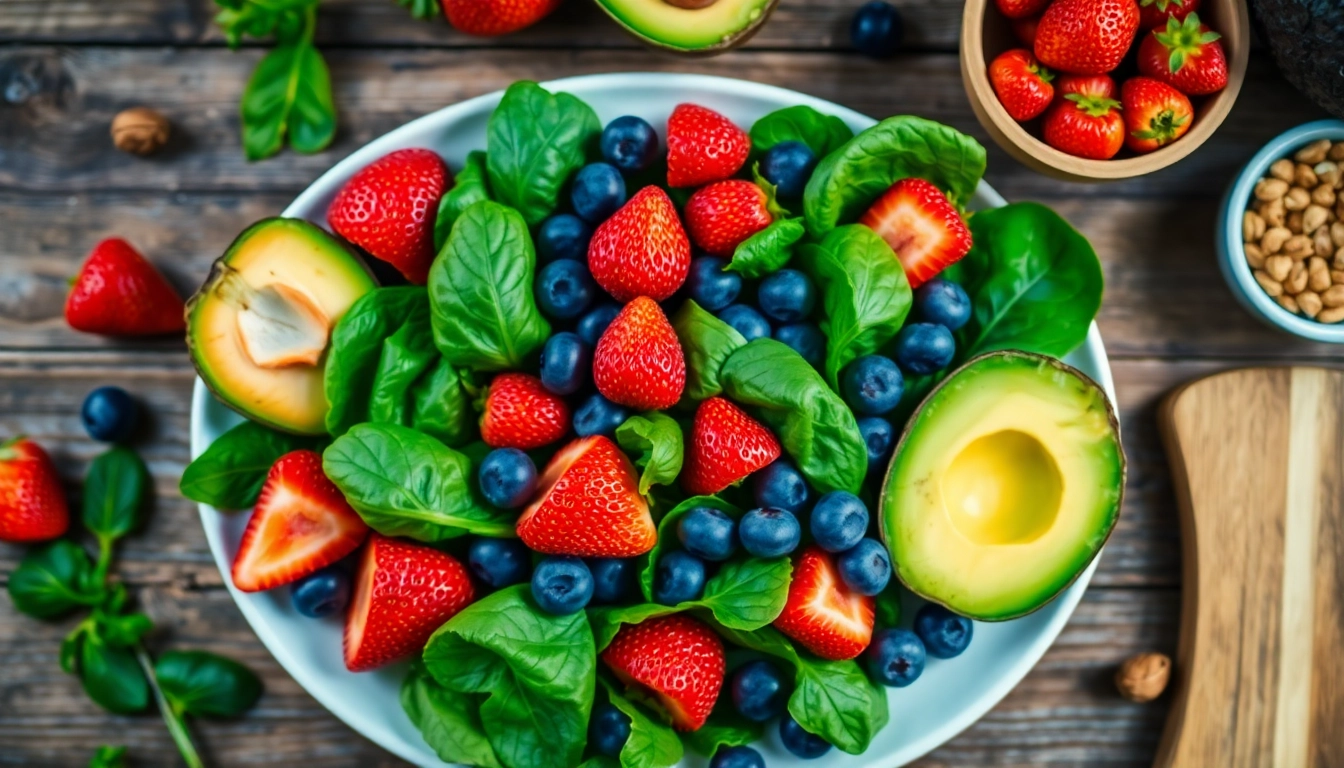Understanding Healthy Food Choices
The concept of healthy food is often clouded by misinformation, dietary fads, and marketing strategies that can lead consumers astray. In today’s health-conscious world, understanding what constitutes healthy food is crucial for making informed choices. Healthy food options often provide essential nutrients while promoting overall wellness, weight management, and disease prevention. But what exactly does “healthy food” entail? Let’s delve into the principles behind sustainable, nutritious eating.
What Constitutes Healthy Food?
Healthy food choices include a variety of whole, minimally processed foods that support bodily functions and boost health. These foods can be categorized into several groups:
- Fruits and Vegetables: High in vitamins, minerals, fiber, and antioxidants, these should form the cornerstone of any healthy diet.
- Whole Grains: Foods such as quinoa, brown rice, and oats provide essential carbohydrates and fiber, contributing to sustained energy levels.
- Healthy Fats: Sources like avocados, nuts, and olive oil contain beneficial fatty acids that support heart health.
- Lean Proteins: Options such as chicken, fish, beans, and legumes not only build muscle but also promote satiety.
- Dairy or Alternatives: Low-fat or plant-based alternatives are fantastic sources of calcium and other vital nutrients.
Notably, the proportion of these foods consumed can significantly influence overall health; balance is vital.
The Importance of Nutritional Balance
Maintaining nutritional balance is central to healthy eating. It involves consuming the right amounts of various food groups to support optimal body function. The concept can be visualized through models like the Healthy Eating Plate, which encourages individuals to visualize their plates as consisting of 50% vegetables and fruits, 25% whole grains, and 25% healthy proteins. Key elements of nutritional balance include:
- Variety: Incorporating a wide range of foods ensures you get different nutrients.
- Moderation: Watching portion sizes is essential to avoid excessive calorie intake.
- Quality: Choosing nutrient-dense foods over calorie-dense or sugar-laden options promotes health.
Identifying Healthy Food Myths
As the healthy food landscape has evolved, numerous myths can mislead consumers. A few common misconceptions include:
- All fats are bad: Not all fats contribute to poor health. Healthy fats are essential for well-being.
- Carbs are the enemy: Whole grains and fruits are essential for energy and should not be entirely avoided.
- Gluten is harmful for everyone: Gluten affects only those with celiac disease or gluten sensitivity; many can tolerate it well.
Understanding these myths can guide consumers toward healthier and informed dietary choices.
The Benefits of Incorporating Healthy Foods into Your Diet
Adopting a diet rich in healthy foods brings numerous benefits, from improving physical health to enhancing mental well-being. Let’s explore these advantages in detail.
Health Improvements from Healthy Food
Research consistently shows that diets rich in whole foods lead to significant health improvements. Studies have shown that incorporating more fruits and vegetables not only helps maintain a healthy weight but also lowers risks associated with chronic diseases. For instance:
- Heart Disease: Diets high in fruits, vegetables, and whole grains may lower blood pressure and reduce cholesterol levels.
- Type 2 Diabetes: Consuming high-fiber foods can help regulate blood sugar levels.
- Cancers: Antioxidants and phytochemicals found in healthy foods can combat oxidative stress, potentially lowering cancer risks.
With ongoing research, the evidence supporting the health benefits of nutritious foods continues to strengthen.
How Healthy Food Affects Mood and Energy
Nutrition goes beyond just physical health; it profoundly influences mood and cognitive functions. Studies have indicated that diets rich in nutrients correlate with decreased symptoms of depression and anxiety. Certain nutrients, such as omega-3 fatty acids from fatty fish, can enhance brain health and improve mood stability.
Moreover, adequate energy levels are crucial for productivity and mental clarity. Properly balanced meals that include complex carbohydrates, healthy fats, and proteins can prevent energy crashes and sustain focus throughout the day.
Long-Term Health Benefits of Healthy Foods
The long-term impacts of consistent healthy food choices are profound. By integrating these elements into your diet habitually, you may:
- Enhance longevity and quality of life.
- Reduce the incidence of lifestyle-related diseases.
- Improve physical fitness and wellness.
These cumulative benefits create a robust case for committing to healthier eating practices over time.
Practical Steps to Integrate Healthy Food into Your Diet
Transitioning to a healthier diet doesn’t have to be overwhelming. Here are some actionable steps you can take to integrate healthy foods into your routine effectively.
Meal Planning for Healthy Eating
Meal planning allows individuals to strategically choose healthy foods, saving time and money while reducing the temptation to opt for unhealthy options. Consider the following steps:
- Develop a weekly meal plan that includes breakfast, lunch, dinner, and snacks.
- Create a shopping list based on your plan to ensure you have all the necessary ingredients.
- Prep meals in advance, which can simplify healthy eating on busy days.
Consistent meal planning can streamline healthy eating habits and enhance dietary adherence.
Shopping Tips for Finding Healthy Foods
When grocery shopping, making wise choices can be simplified with a few strategies:
- Stick to the perimeter of the store: Fresh produce and whole foods are generally located in these areas.
- Read labels: Look for items with minimal added sugars, salt, and preservatives.
- Buy in bulk: This can often lower costs and reduce packaging waste.
By being informed and selective, shoppers can make healthier choices that align with their dietary goals.
Making Healthy Food Accessible at Home
Creating a healthy environment at home is key to maintaining healthy eating habits. Here are some suggestions:
- Stock your kitchen with healthy snacks to reduce temptation during hunger pangs.
- Organize your pantry to have healthy foods at eye level.
- Create designated meal prep days to maintain a supply of healthy options throughout the week.
Accessibility to healthy food can lead to frequent healthier choices.
Healthy Food Recipes for Every Meal
Cooking at home is one of the best ways to control what you eat. Here are some delicious and nutritious recipes to inspire your healthy eating journey.
Breakfast Recipes Featuring Healthy Foods
Breakfast is often considered the most important meal of the day. Here are two nutritious options:
- Avocado Toast: Spread smashed avocado on whole-grain bread and top with a sprinkle of sea salt, red pepper flakes, and a poached egg.
- Berry Smoothie: Blend together spinach, mixed berries, Greek yogurt, and a splash of almond milk for a refreshing boost.
Easy Lunch Options with Healthy Ingredients
Maintaining healthy choices at lunch can keep energy levels up. Try these:
- Quinoa Salad: Mix cooked quinoa with chickpeas, diced cucumbers, cherry tomatoes, and a lemon vinaigrette.
- Hummus and Veggie Wrap: Spread hummus on a whole-grain wrap and fill with assorted veggies and a sprinkle of feta cheese.
Simple Healthy Dinners for Busy Nights
Simple, quick dinners can be nutritious and satisfying. Consider these options:
- Stir-Fried Tofu with Veggies: Sauté cubed tofu with bell peppers, broccoli, and snap peas; serve over brown rice.
- Baked Salmon with Sweet Potato: Season salmon fillets and bake alongside sweet potato wedges.
Overcoming Challenges to Maintain Healthy Eating
While committing to healthy eating is rewarding, it can come with its own set of challenges. Here are strategies to overcome common barriers.
Addressing Healthy Food Cravings
Food cravings can pose a significant threat to maintaining healthy dietary habits. Here are tips to manage them:
- Prioritize hydration, as thirst can often be mistaken for hunger.
- Try to find healthy substitutes for cravings, such as air-popped popcorn for chips or fruit for desserts.
- Practice mindful eating by paying attention to your hunger signals and really savoring your food.
Finding Support for Dietary Changes
Making lasting changes is often easier with support. Consider:
- Joining a community group focused on healthy eating or cooking classes to stay motivated.
- Enlisting a friend or family member to embark on a healthy eating journey together.
- Consulting with a dietitian who can provide personalized guidance tailored to your needs.
Tracking Progress with Healthy Food Goals
Establishing measurable goals can significantly enhance accountability. Here’s how to effectively track your progress:
- Use a food diary or mobile app to log meals and reflect on dietary habits.
- Set specific, achievable goals like incorporating a new vegetable into meals each week.
- Regularly review and adjust your goals based on personal progress and experiences.



